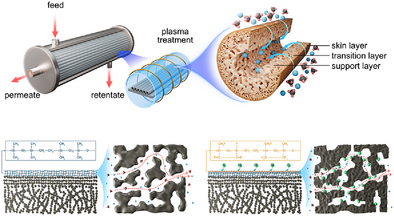Plasma-Engineered Sub-10 nm Surface Fluorination Enables Ultraselective Hollow Fiber Membranes
Graphical Abstract
Surface fluorination of PDMS-coated hollow fiber membranes via CF4 plasma engineering achieves sub-10 nm nanoscale modification, simultaneously enhancing chain rigidity and narrowing pore size distribution. The optimized membrane demonstrates record gas separation performance with industrial-scale stability, surpassing the 2019 perfluoropolymer upper bounds and conventional polymeric hollow fiber membranes.
Abstract
While polymeric hollow fiber membranes (HFMs) offer scalable solutions for gas separations, their performance is fundamentally limited by the permeance-selectivity tradeoff and imprecise microporosity regulation. Herein, we propose a surface fluorination strategy using carbon tetrafluoride (CF4) plasma to engineer a sub-10 nm fluorinated and crosslinked layer on polydimethylsiloxane (PDMS)-coated Matrimid® HFMs. Through precise modulation of plasma parameters, we achieved controlled substitution of PDMS methyl groups/methyl hydrogen atoms with fluorine species (up to 27.7 mol% F content), 5.3-fold enhanced chain rigidity via fluorine-induced interchain interactions and steric hindrance, as well as narrowed pore size distribution with preferential ultra-micropore filling. The optimized HFM-50W-65Pa-500s membrane exhibits record-breaking He/N2 and He/CH4 selectivities of 1202 ± 13 and 1790 ± 12 with 170 ± 2 GPU He permeance, surpassing perfluoropolymer upper bounds and outperforming previously reported polymeric HFMs. Remarkably, it demonstrates molecular discrimination precision (α(He/CO2) = 56 ± 2.2, α(He/H2) = 4.1 ± 0.2) for pure-gas and attractive ternary He/(CO2+CH4) selectivity of 1005 ± 20 under 40-bar mixed-gas conditions while maintaining 720-h operational stability. This plasma-engineered fluorination paradigm combines nanoscale precision with industrial scalability, opening new avenues for advanced membrane design.
Conflict of Interests
The authors declare no conflict of interest.
Open Research
Data Availability Statement
The data that support the findings of this study are available from the corresponding author upon reasonable request.





